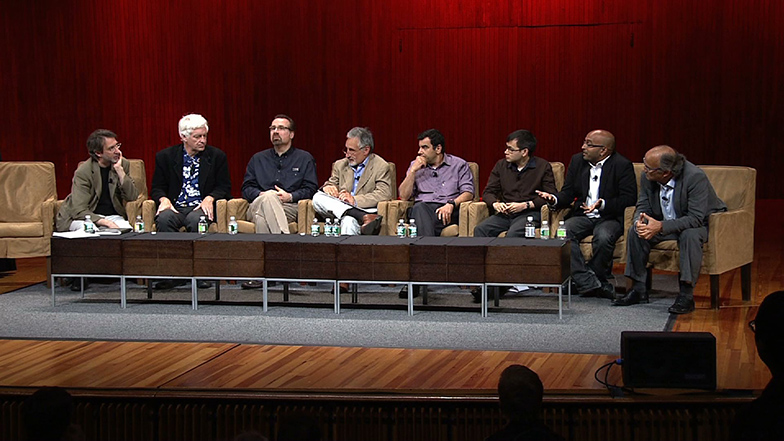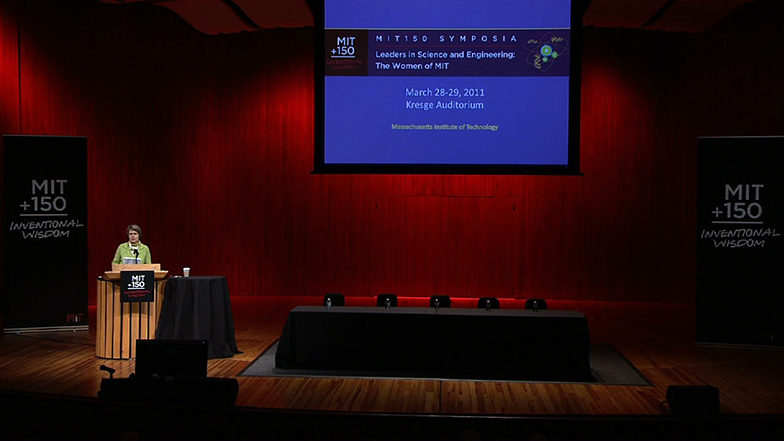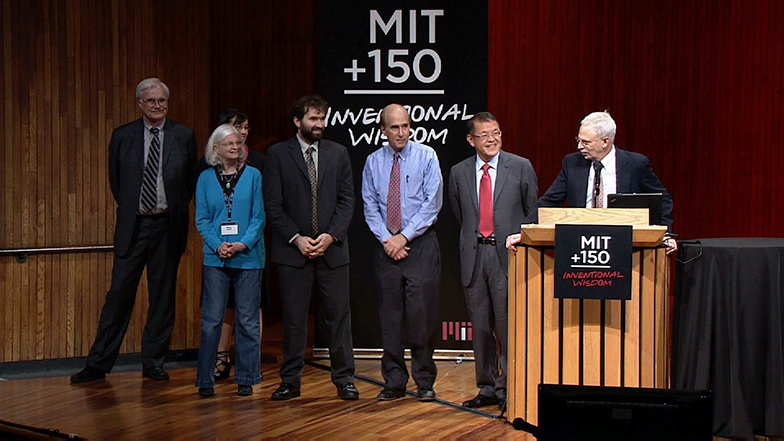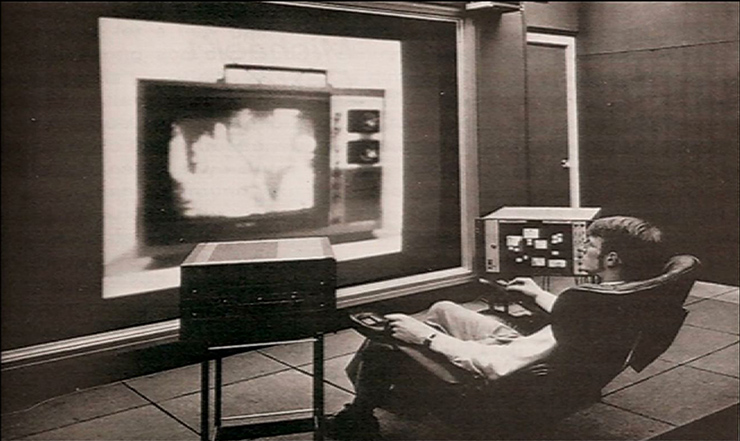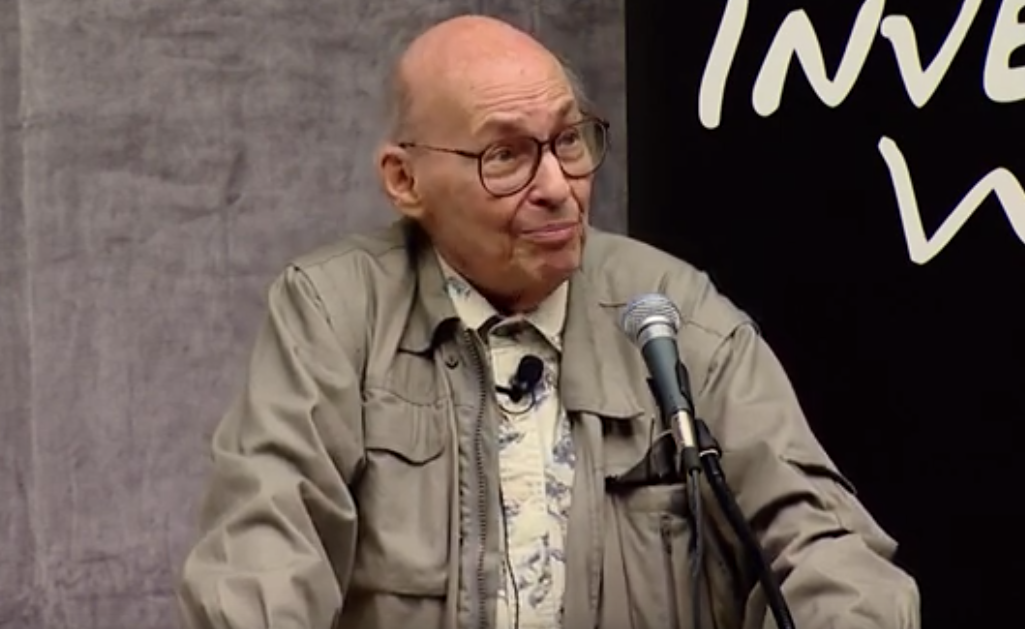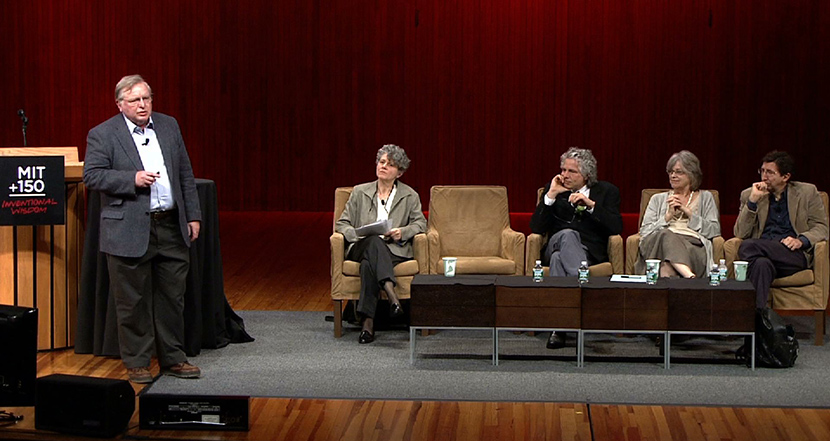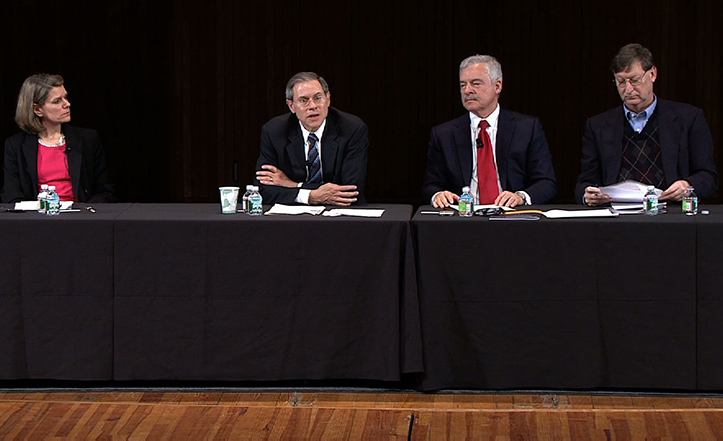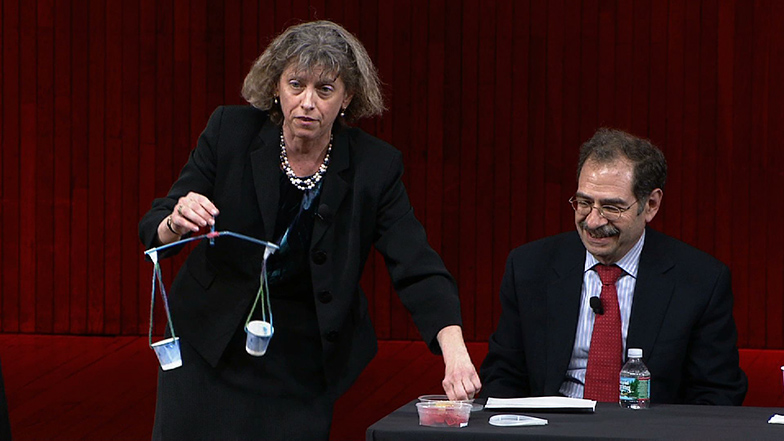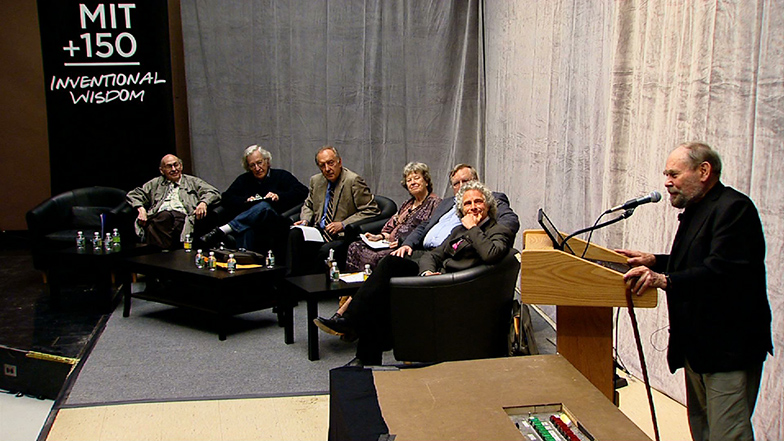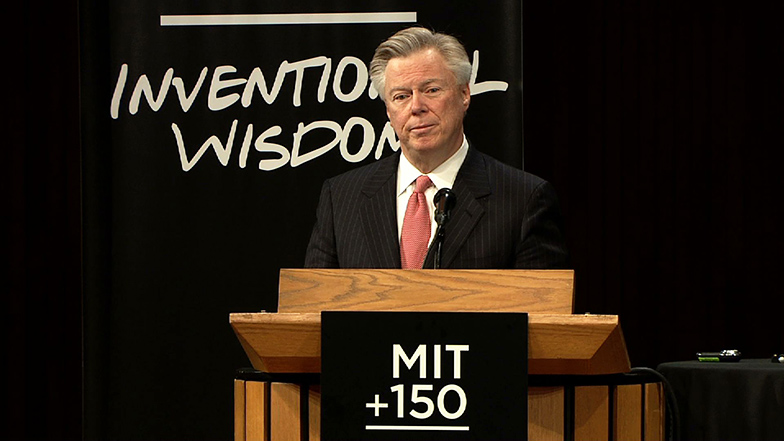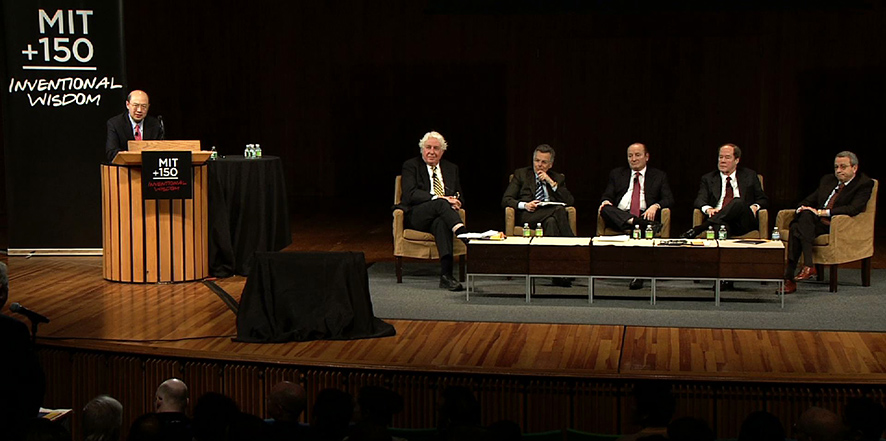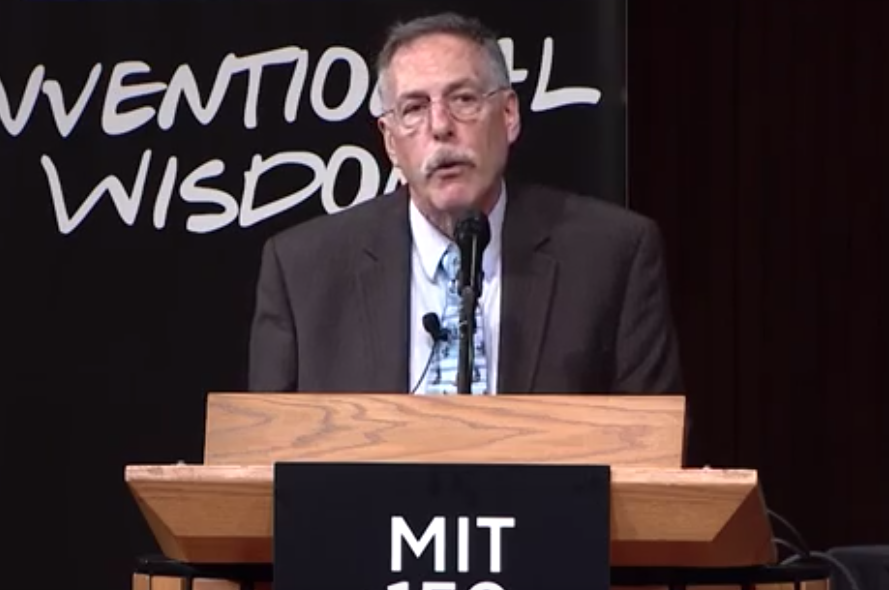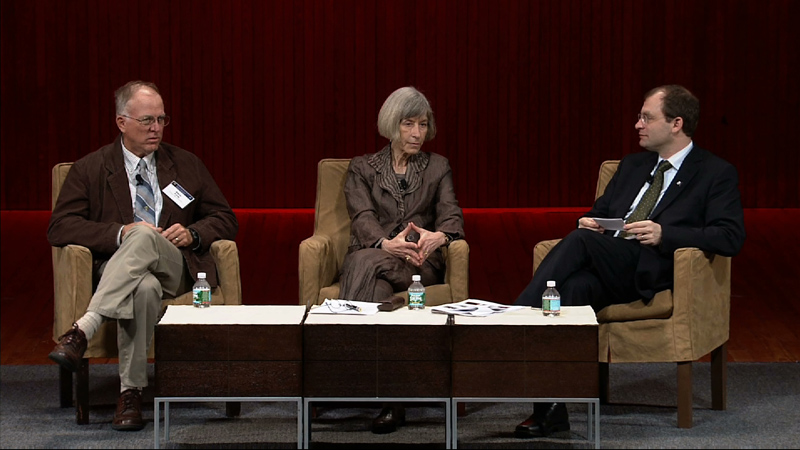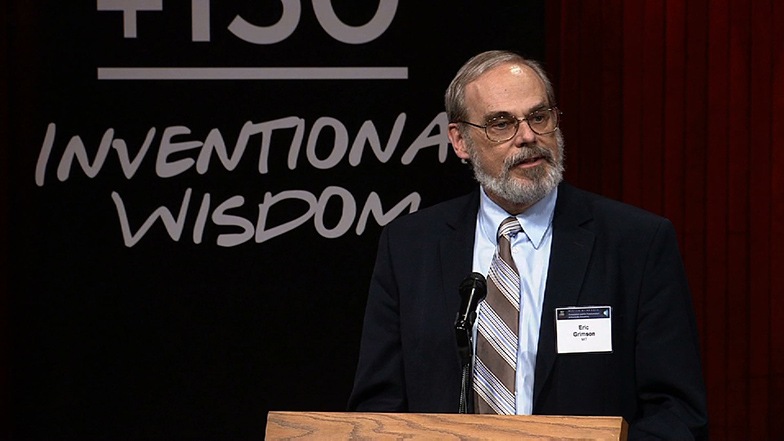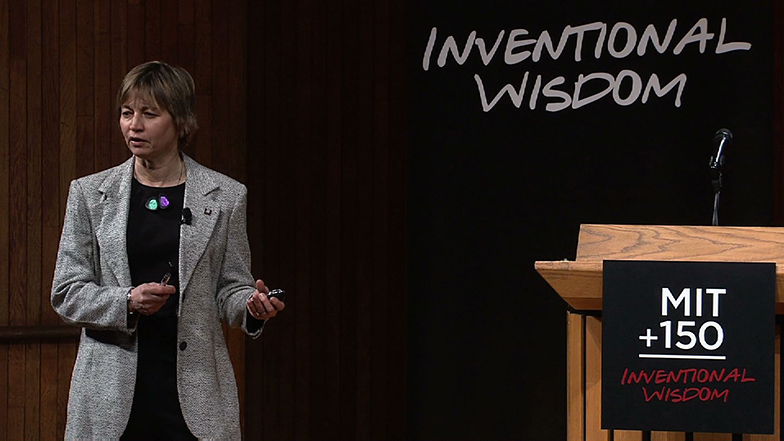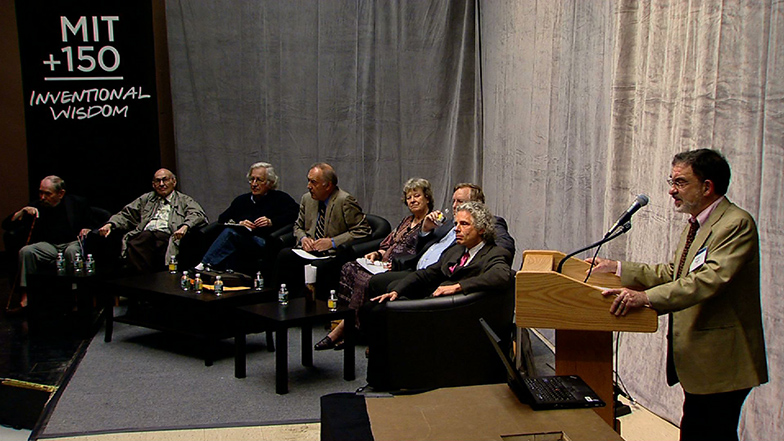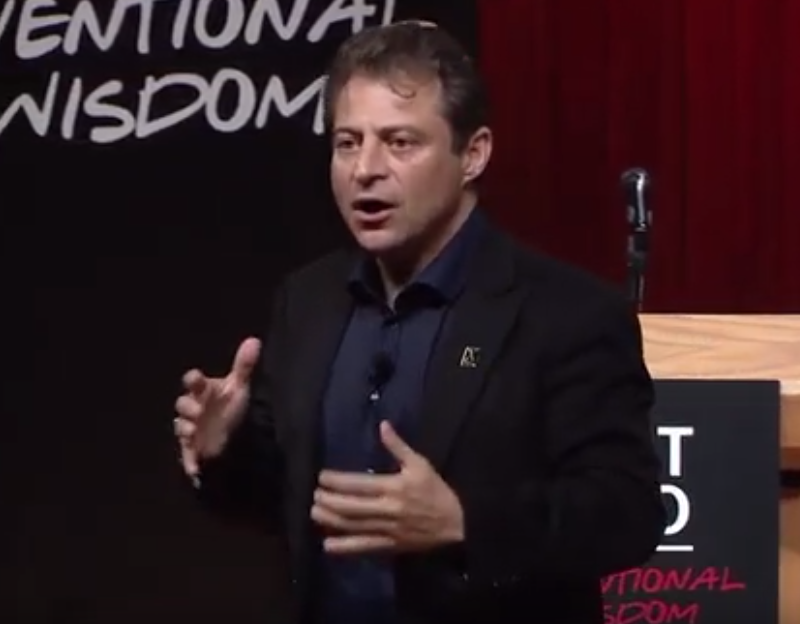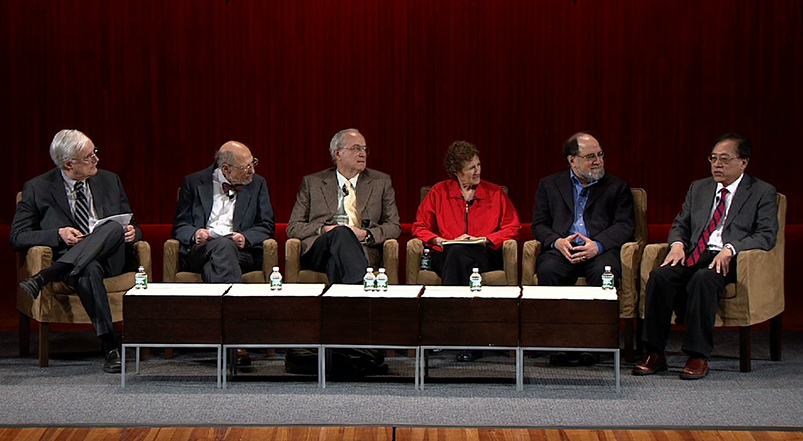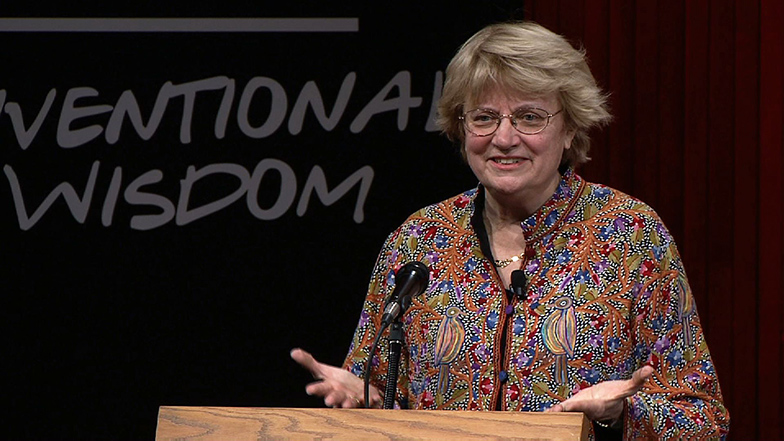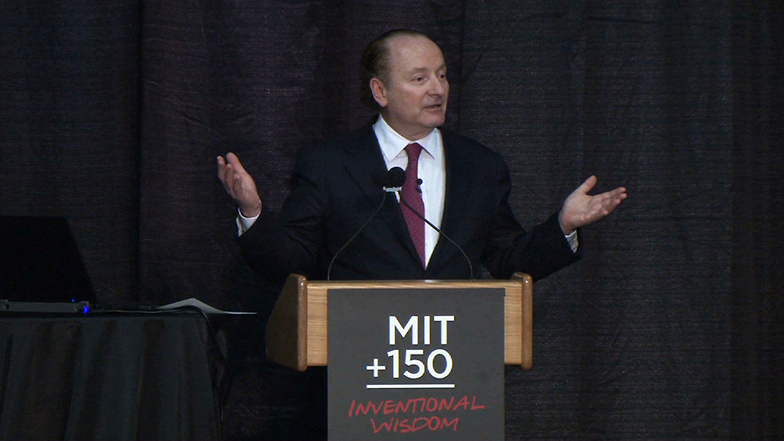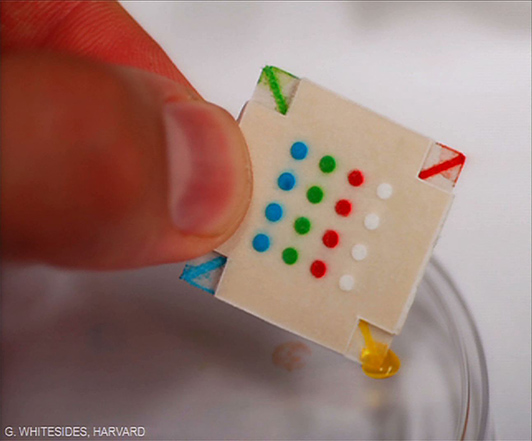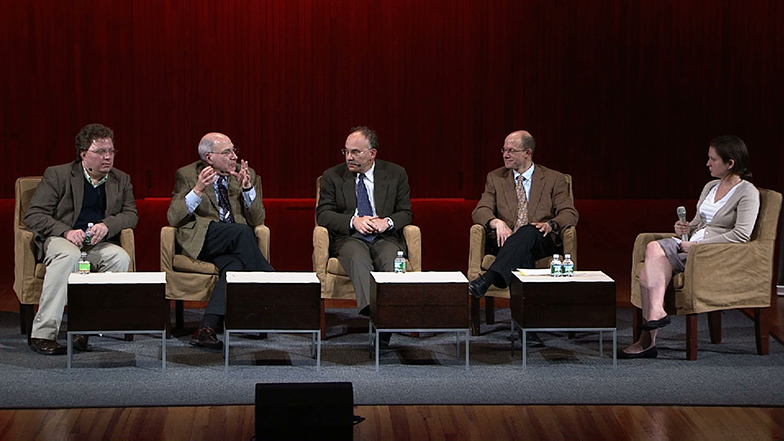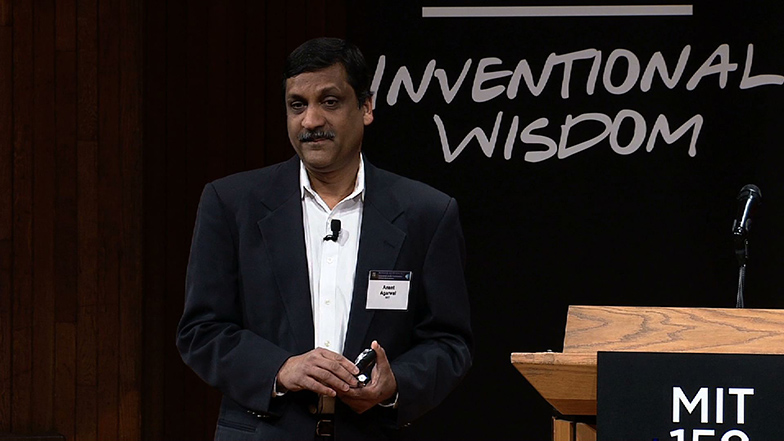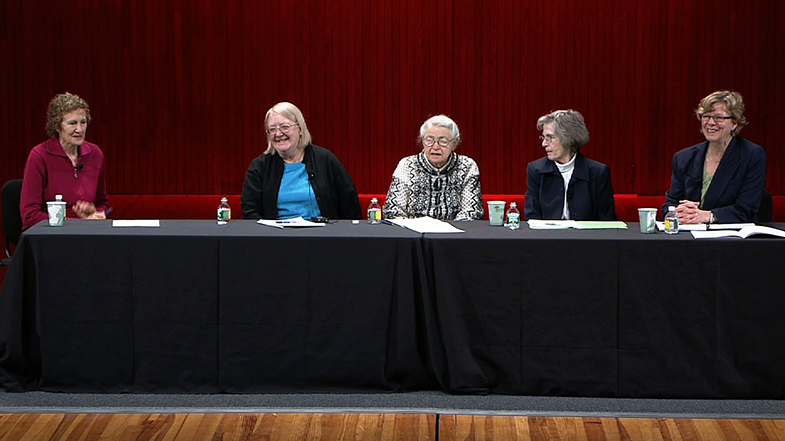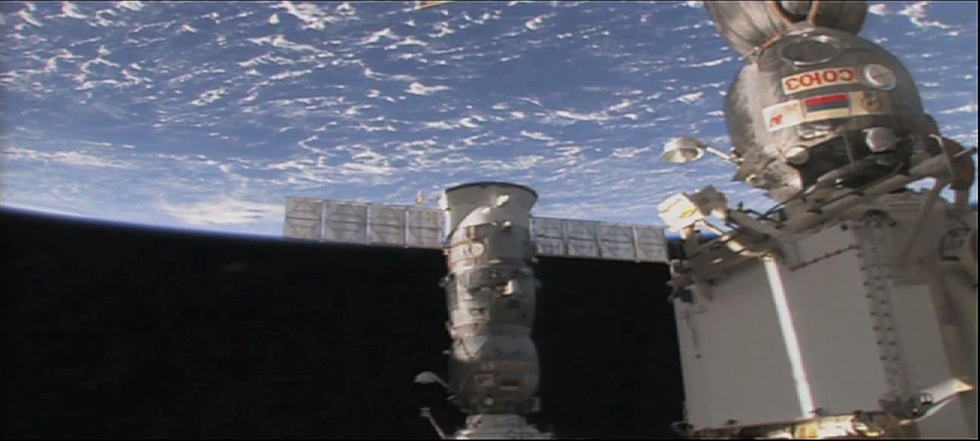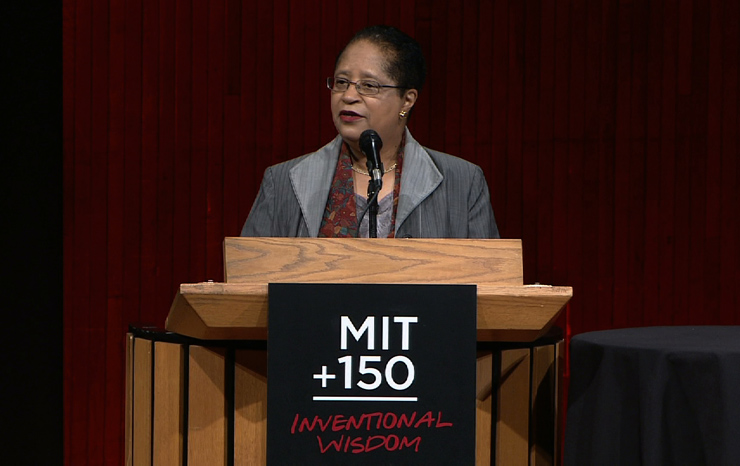Women of MIT: Academic Leaders—Perspectives and Current Challenges
WAITZ: Welcome. I will be introducing the speakers for the next session. I'd first like to thank Professor Hopkins for an inspiring keynote address. I really thought it was terrific. It caused me to think a little bit about my own view of that trajectory that you showed.
So I've had the opportunity to see that through the eyes of someone else, because my wife is a faculty member here at MIT in civil environmental engineering. So over the last 15 or 20 years, I've gotten to get a healthy dose of her views about all of this.
And I think the most tangible piece of data for me is that our first daughter was born 12 years ago. Just had her birthday. And at that time, my wife was a year or year and a half before tenure. And there were no automatic leave policies beyond those specified by Massachusetts law at the time, and certainly no automatic extension of the tenure clock.
And our second daughter was born nine years ago. And by that time, we had family leave policies in place and shortly thereafter, automatic extension of the tenure clock. So it impresses upon me how much progress has been made but also how recent a lot of the progress has been and how much progress we have still to go.
So thank you for just a really terrific keynote. So it's my great honor and pleasure to introduce our speakers today-- Dr. Shirley Ann Jackson and Dr. Charles Vest. I'll start with Dr. Jackson, and she will make remarks. And then I will introduce Dr. Vest. And then they will both be here to answer your questions.
So Dr. Jackson is president of Rensselaer Polytechnic Institute. She received her bachelor's and PhD from MIT in '68 and 1973. She's been a researcher at Fermilab and CERN, AT&T Bell Labs, a faculty member at Rutgers, where she has conducted research in theoretical physics, solid-state and quantum physics, and optical physics. She served as chairman of the US Nuclear Regulatory Commission from 1995 to 1998 and then president of RPI since 1999.
She's the holder of 45 honorary degrees, a member of at least a dozen professional and honor societies, many, many major awards, including the-- in 2008-- the American Society of Mechanical Engineers' Ralph Coats Roe Medal, in 2007, the Vannevar Bush Award from the National Science Foundation, among many others.
She was appointed by President Barack Obama to the President's Council of Advisors on Science and Technology in 2009. She chairs the New York Stock Exchange regulation board, serves on the Board of Regents of the Smithsonian Institution.
She's a member of the board of the Council on Foreign Relations, a trustee of the Brookings Institution, and the university vice chairman of the US Council on Competitiveness, to name just a short list from amongst a much longer list of service roles she has. She was described by Time magazine in 2005 as perhaps the ultimate role model for women in science. Dr. Jackson--
JACKSON: Thank you, Dr. Waitz, for that kind introduction, and good morning. It is always a pleasure for me to return to Cambridge, particularly when the event offers an opportunity for me to interact directly with MIT students and faculty, especially at a time in its history when it is being led by a neuroscientist who happens to be a woman, one focused on the key role of science and technology in solving national and global challenges. Equally pleasurable is the opportunity to share this podium with my esteemed mentor and friend, Dr. Charles Vest.
As an alumna and a life member, in fact, of the MIT Corporation, and as president of Rensselaer Polytechnic Institute, I naturally am concerned with the situation of women in science and engineering careers, particularly careers in research-intensive universities.
Now, the groundbreaking work conducted at MIT that resulted in the 1999 report, a study on the status of women faculty in science at MIT, was not the first attempt to understand the special challenges faced by female faculty. But it raised the profile of such studies and importantly, laid the groundwork for self-scrutiny at many other institutions.
In fact, since then, the National Academies-- and I'm not going to say what Chuck will say. But the National Academies have studied the problem on a national scale, releasing two major publications-- the first, Beyond Bias and Barriers-- Fulfilling the Potential of Women in Academic Science and Engineering in 2007 and Gender Differences at Critical Transitions in the Careers of Science, Engineering, and Mathematics Faculty in 2010.
A quote from the just-released MIT report, in fact, one used by Nancy Hopkins in her fabulous and important keynote, seems to be an appropriate starting point for my remarks. And that is this is a celebration with caveats. If one looks at the numbers, the progress in opportunities, awards, and enabling mechanisms for women is encouraging. These are satisfying intellectually, and they point to objective accomplishments.
Reading quotes from the faculty who are involved touches the heart and may provide the most compelling evidence of change, because for most of MIT's history, I doubt that any woman would have said, and I quote, "This has been a fabulous place to work." And yet, in spite of the great progress here, I cannot help but be disappointed by how limited in many ways the progress has been nationally.
After 10 years, 10 years from the time, roughly, that MIT riveted attention on these issues, we are still a long way from gender equity in science and engineering. Now, in the 1999 MIT report, professor Lotte Bailyn said, and I quote, "Gender discrimination in the 1990s is subtle but pervasive and stems largely from unconscious ways of thinking." That is what she said. And it is interesting what Nancy Hopkins had to say this morning about it.
But I would argue that the challenge of the 1990s is still a challenge today. Not knowing, not understanding, and not intending does not get us off the hook. We are still responsible for bias that puts obstacles in front of talented and capable people.
This is both a moral problem, because of course, we value justice. But importantly, it is a practical problem, because we as a society are denying ourselves the insights, the ingenuity, and the expertise of competent, talented people at a time, again, when we face immense global challenges.
The response to the 1999 MIT report was immediate, with broad press coverage and a deluge of emails, phone calls, and letters. MIT woke people up. A direct outcome of the report was seen in the initiation of investigations across other schools at MIT.
In addition, the so-called Group of Nine, a group of nine elite universities-- in case you don't know-- Berkeley, Caltech, Harvard, MIT, Princeton, Stanford, Michigan, Penn, and Yale. The Group of Nine, so-called group of nine, came together and the Gender Equity Project was created.
Six of these institutions completed their own studies that paralleled the MIT approach. Their findings on gender equity showed similar patterns of under-representation and bias. But beyond recognizing the issue of gender equity and revealing it in compelling terms, MIT also put, as you know, the report recommendations into effect and shared these as best practices.
The policies that emerged were research-based, not assumption-based. The result is that changes have occurred across much of academia, because greater efforts are made to recruit women. Women are invited onto key, influential committees. The tenure clock has been made more flexible at some universities.
Now, so with respect to its external success, women have demonstrated that they have the ability and drive to succeed in science and engineering. And there is no question that participation by women in academic science and engineering careers has grown in recent years.
What is more, women who apply for faculty positions in mathematics, science, and engineering at major research universities now are hired as often as and sometimes more than men. And of those considered for tenure, women are beginning to receive tenure at the same-- and in some fields-- higher rates than men.
However, the 2010 gender differences report found that women continue to be underrepresented among academic faculty relative to the number who receive science and engineering degrees. And they are not applying for tenure-track jobs at research-intensive universities at the same rate at which they are earning doctorates.
For example, while women received 45% of the PhDs in biology awarded by research-intensive universities between 1999 and 2003, they represented only 26% of applicants to tenure-track positions at these universities. And women also spent a significantly longer time as assistant professors.
But you know, the problem is not limited to the United States. The need for engineers and scientists is growing throughout the Western hemisphere. Germany expects to have a shortfall of 200,000 engineers by 2017. And Great Britain will need more than half a million skilled workers. But only 18% of tenured professors in 27 countries of the European Union are women.
In a March 2010 New York Times article, Katrin Bennhold observed that, and I quote, "In the 21st century, perhaps more than ever before, there will be a premium on scientific and technological knowledge. Science, in effect, will be the last frontier for the women's movement.
With humanity poised to tackle pressing challenges from climate change to complex illness to the fallout from the digital revolution, shortages of people with the right skill sets loom in many countries. Therein lies both opportunity and risk for women. In the years to come, the people who master the sciences will change the world and most likely command the big paychecks."
Now, that is what she said. Now, this is a rosy view. But how do we get there? What we are learning is that we do not still understand the problem fully. Despite aggressive steps taken by universities to promote faculty diversity, under-representation of women at all faculty levels persists. And strategies such as targeted advertising and targeted recruiting have not proven entirely effective.
A difficulty has to do with perhaps bridging to the next level. Now interestingly, a study by Cornell University researchers found that efforts such as gender sensitivity workshops to prevent discrimination are not particularly effective, because women do not, in fact-- and this is the Cornell result-- face discrimination in hiring, interviewing, or grant and manuscript reviewing at the university level.
This study suggests that the major culprit was timing, that women find it extremely difficult to earn tenure and to raise children at the same time. Ironically, research reveals that parenthood has a positive effect on men's success in academic careers. While mothers who sacrifice work for parenting are seen as neglecting their jobs, fathers who make the same choice are admired and rewarded.
Writing for the New York Times, Steven Greenhouse noted that based on a University of California-Berkeley study, Keeping Women in the Science Pipeline, women are far more likely than men, as you've heard anyway, to leak out of the research science pipeline before obtaining tenure at a college or university. After receiving a doctorate, married women with young children, in fact, are 35% less likely to enter a tenure-track position in science than are married men with young children and PhDs in science.
According to the report from the University of California-- and this is a quote-- "women who had children after becoming post-doctoral scholars were twice as likely as their male counterparts to shift their career goals away from being professors with a research emphasis, a 41% shift for women versus 20% for men."
And a 2005 report from Virginia Tech found a disproportionate share of women make up voluntary departures from the faculty, because there, although women represented one fifth of the faculty, they accounted for 2/5 of the departures.
At every step along the way, from entering college as a science or engineering major to graduating with a technical degree, from entering graduate school to exiting successfully, to getting a post-doc, to succeeding as faculty, to attaining tenure, we need to provide women with bridges to the next level.
Now, as is clear from the studies I mentioned, the unequal burden of family life turns the gaps in the road into chasms. Help with childcare, which clearly has been provided at MIT, and the establishment of a parental childbirth leave, which has been provided at Rensselaer, coupled with leaves with support for graduate students who have children can help. But there is more to be done.
Studies show that while female faculty may not feel discriminated against, they do still more often feel isolated and marginalized in their professional lives than their male counterparts. The gender differences report found that women who had a mentor did better than women without one. In fact, investigators found, for example, that in chemistry, female assistant professors with mentors had a 95% probability of securing grant funding compared to 77% for those without mentors.
Recognizing the importance of mentoring, the National Science Foundation provides grants through a program called ADVANCE, which stands for increasing the participation and advancement of women in academic science and engineering careers. A program funded by ADVANCE at Rensselaer is called RAMP-Up, which is our shorthand for Reforming Advancement Processes through University Professions.
RAMP-Up's advancement reforms are intended to benefit the tenure-track faculty at Rensselaer with special emphasis on women, particularly minority women, as well, in NSF-funded disciplines. Our activities are designed to impact individual faculty, department schools, and the university as a whole.
At the level of the individual, RAMP-Up initiatives include communication and networking through colloquies, workshops, and retreats, as well as grants through career campaign awards to help women get over the hump, as it were. At the level of the department, RAMP-Up initiatives include training for department heads as well as grants for cultural change initiatives.
At the level of the school, RAMP-Up initiatives include the appointment and activities of faculty coaches who serve as information resources and participants in the school's advancement processes. And at the level of the university, RAMP-Up initiatives include intervention on behalf of individual faculty, fairness in promotion and tenure reviews, and a senior pipeline search.
Now, in the end, when a woman comes up for tenure, the decision is strictly made on the basis of what she has accomplished. But the point is to not have a leaky pipeline along the way. And so the program provides vital help, but there is still unfinished business. And so let me point out a few things that I see on the horizon that, in fact, may create new challenges or maybe repackage challenges.
The first is the shifting context for measurement. To begin, for those who are on the vanguard of gender equity, a subtle problem may, in fact, emerge-- competition. Because as gender equity becomes more valued by our culture, the measure may somewhat decline in influence because the pool of applicants will have more options.
Now the answer, of course, is to increase the pool of applicants, which in no way has been exhausted. However, we will need to look closely to distinguish declines based on a failure to execute, versus changes in demand.
Another concern reflected in the report is that family and gender issues are still viewed as women's issues. Now MIT has embraced gender issues as an institutional challenge, but beyond the campus of MIT, these issues are still perceived as the province of women. Now, this is unfortunate for a couple of key reasons. It automatically lowers the priority of gender equity, putting it into a box often unexamined by others, that is a special interest on the part of the population, not all of the population.
It excludes as well the talent, the insight, the effort, and the wisdom of men. And so it makes solutions to gender equity more vulnerable to criticism and dismissal. Because engagement is an essential element of social change and the more distant a directive or direction is from those who must participate in its implementation, the less chance that it will be well executed.
Another challenge we may see will be renewed resistance and new and creative reactions from those who feel threatened by gender equity or those who struggle with the changes it produces, particularly at a time when people are worried about their economic security overall. Interestingly, earlier this month the US Civil Rights Commission decided to abandon an investigation into whether colleges are discriminating against women in admissions.
But this is not just a matter of our society perhaps stepping backwards. The world changes. And if we focus only on what we have seen before, we may miss what will matter for the next generation. So let me offer a few examples.
First, there is one area of engineering that has achieved equity, essentially. Do you know what it is? Well, the number of men and women majoring in biomedical engineering is close to even. And guess what? The salary for biomedical engineers is flat or going down.
Veronica Arreola, director of the Women in Science and Engineering Program at the University of Illinois at Chicago has been quoted as saying, "Engineering fields where women are less than 20% pay more." So this, what some call pink-collar discrimination, is something to watch out for.
But where does it come from? The MIT report mentions a concern that standards drop as women move toward equity in fields. Is the value provided by women being questioned?
Other studies show that women's pay drops because of perhaps the double bind of negotiations. If women do not negotiate aggressively, they may lower the price for their field's expertise. If they do negotiate aggressively, especially in academia, they are not considered to be collegial and may be denied promotion or tenure. Now, I negotiate aggressively, but--
[LAUGHTER]
Another factor-- and I'm always one who's always willing to walk off the cliff-- is, in fact, the uncertain impact of internationalization and multiculturalism. Here's another factor to consider. In 2009, about half of all PhDs in physics, math, and computer science went to non-US students. And 55% of engineering doctorates went to the foreign-born.
I think that's a good thing. It says we attract great talent. But what impact may this have on our hopes for gender equity? An optimistic person might suspect that our efforts to make science and engineering more welcoming in the US would create a stampede of young women from other nations.
But this may not be the case. A 2006 University of Virginia study of graduate students in computer science found essentially no difference in the percent of women between US and international students. The report concludes, and I quote, "Increasing international students in US programs is not likely to improve the gender balance in computing. To accomplish that goal, we will have to attract more women, regardless of their citizenship." That is the quote.
So as we seek to import people of talent and vision from abroad, we also must grapple with traditions and cultural references that may make it more difficult for the equal status of women to be gained and accepted. And attitudes that threaten the as yet insufficient gains we've seen, may not be limited to just male scientists and engineers from developing countries, which is what people default to in their thinking.
In Sweden, women are awarded 44% of biomedical PhDs, yet account for 25% of post-doctorates and only 7% of professorial positions. A major study in 1997 of the peer review system of the Swedish Medical Research Council showed that a woman at that time had to be 2 and 1/2 times more productive than a man to be considered equally competent.
Now, to be sure and to be fair, in some countries women have made great strides in participation in science and engineering and in assuming leadership positions in these fields.
Now, let me talk about a new area-- social networks. Have you ever thought about that and what effect that might have? Now, as we have seen in these sweeping changes across the Middle East and North Africa, social networks have had a significant influence. In fact, a number of women have been engaged in helping to drive change and have participated in social media, which have helped to enable change.
But interestingly enough, a report in January that Wikipedia is authored by men 85% of the time is quite interesting, especially since-- for all of its obvious limitations-- Wikipedia, it turns out, is used as a source of information by 48% of American adults. And so an argument is raging about whether the encyclopedia that, quote, "anyone can edit," unquote, possibly is skewed in favor of men. Or is it a choice, where women just opt out of it?
Now, we already know that social networks are becoming integral to the education of our students. And they may be key, and likely will be, to how the next generation will be introduced to science and engineering and how they will build relationships and careers. And therefore, as we continue to work toward gender equity, we cannot neglect actually what happens in social networks. And as a university president, I'm not clear that we really understand social network communities-- the effect on cognition and learning, social development, bias development.
And so actually at Rensselaer, we have a research center focused on social and cognitive networks that is sponsored by the US Army. And it is interesting in this regard. Why? Well, the center is studying the technology of such networks but also studying how constituency groups form in such networks, how adversary groups form, how trust is developed, how truth and rumor are sorted out, and what cultural influences and nuances are at work.
But why is gender equity important? And it is important beyond academia. If the United States is to maintain its scientific and engineering leadership in the 21st century and to contribute to helping to solve global challenges, it must have the full creative and entrepreneurial participation of all of its people and must continue, as well, to tap talent from abroad.
But as long as women face barriers that inhibit their success in research-intensive universities, the nation will be deprived of this vital source of talent, whether drawn domestically or globally. Our national and global future and social stability will be at risk. High-profile events such as this symposium are critically important to identify and eliminate these barriers to full participation of women in science and technology.
Now, I will add that past experience shows that efforts toward fairness often provide broad benefits. One obvious advantage to gender equity is that gender equity provides experience and models for developing more equitable systems for people who were shut out because of race, because of different learning modalities, disabilities, and other differences from the majority that currently holds leadership positions in science and engineering.
On a more basic level, new perspectives and insights pour into fields when the doors crack open, allowing personal lives to flourish together with professional lives through flexible tenure clocks, parental childcare leave, recognition that spouses have careers, and initiatives that encourage work-life balance, make the workplace more humane. And it helps to develop our scientists and engineers as whole people, more engaged with families and communities.
Moreover, understanding and addressing cultural differences as we work through the issues only enhances our ability to tap the complete talent pool. We miss much by excluding people of talent. And it is difficult to imagine our commitment to environmental stewardship without the awareness generated long ago by marine biologist and author Rachel Carson.
The chief champion of the Orphan Drug Act was Abbey Meyers, whose lobbying began when she could no longer get an experimental drug that was helping her son, who has Tourette's syndrome.
And you've heard this morning about Barbara McClintock. Barbara McClintock developed her theory of transposable elements, so-called jumping genes, in the 1940s. She said it was met with puzzlement, even hostility.
She stopped publishing her data in 1953. And it was years and years later that her genius was recognized, because she won the 1983 Nobel Prize in Physiology or Medicine. So one wonders what might have been accomplished-- for as much as she did accomplish-- if her work had been accepted earlier.
So the key message is this-- through commitment to gender equity, we identify, prepare, and enable the people who can uncover new knowledge and who can meet our national and global challenges. Some of the answers are in the MIT study. But I hope that we will continue to broaden our exploration of the issues.
And as we do, I hope we will come to better understand the shifting landscape of equity measurement, the corrosive effect of defining family and gender issues as women's issues, the new face of resistance to equity, the risks of pink-collar exploitation, the uncertain impact of internationalization and multiculturalism on the progress of women in science and engineering, because women of multicultural backgrounds are the invisible women in science, and of course, the emerging role of social networks and their potential impact on women in science and engineering, their participation in the conversation and in the endeavor.
Thank you very much. I look forward to your questions and observations.
[APPLAUSE]
WAITZ: Wow. Terrific-- just a terrific talk. As I noted, I will now introduce our next speaker, and then both Dr. Jackson and Dr. Vest will stay on stage to entertain questions.
So Dr. Charles Vest is the president of the National Academy of Engineering and well known to almost all of us here. But I will share a little bit about his history and some of his honors.
He got his bachelor's at West Virginia University, master's and PhD at University of Michigan, and joined the faculty there in 1968, where he taught in the areas of heat transfer thermodynamics and fluid mechanics and conducted research on heat transfer in engineering applications of laser optics and holography.
He became dean of engineering at the University of Michigan in 1986 and served in that role for three years and then briefly as provost and vice president of academic affairs before joining MIT as president in 1990, a position he held until 2004.
And he's been president of the National Academy of Engineering since 2007. He's a member of many different professional and honor societies, a holder of 14 honorary degrees, a recipient of many, many different awards, including in 2006, the National Medal of Technology.
Like Dr. Jackson, he has a very active service role, including Secretary of Commerce's National Advisory Council on Innovation and Entrepreneurship, Department of State Secretary's Advisory Committee on Transformational Diplomacy, and for Presidents George Bush and Bill Clinton, service on the committee on Advisors on Science and Technology.
Professor Hopkins shared the quote from Dr. Vest-- I'll share it again-- that was in the preface with the release of the 1999 report. He said, "I've always believed that contemporary gender discrimination within universities is part reality and part perception. True, but I now understand that reality is by far the greater part of the balance."
Chuck's candor and his openness set the highest standards with that report. They led the San Francisco Chronicle, among many others at the time, to speculate that the study and Chuck's willingness to admit discrimination together would serve as a catalyst for colleges and universities throughout the country to seriously reevaluate treatment of women faculty members. And I believe the report and Chuck's leadership at the time have done so. Please join me in welcoming Charles Vest.
[APPLAUSE]
VEST: Thank you very much, Ian. It is just wonderful to be back here at MIT and particularly to be here today to celebrate what we are celebrating. And before I begin, I just want to say that I hope everybody here understands what a privilege it was to hear Nancy Hopkins talk this morning. This was a tour de force that few people are privileged to ever hear on any particular topic.
Now, I worried a lot about what I can bring to this. I can certainly not bring either the moral authority nor the depth of analysis that my good friend and colleague Shirley Jackson just brought to the topic. So I will do what I was actually asked to do, which is bring a little bit of personal view to what happened here in the years that we've heard about today and what I think it all means. But I know I will be playing at least third fiddle, and probably before this is all over, something lower than that.
So we are here to celebrate something today. And I think this something has to do with the question are we were looking at a double helix or are we engaged in a race to the top? Because if you look at the percentage of women in our schools of science and engineering, you see this curve.
And the good news is, of course, those of us at MIT always relish competition, I hope in the right sense of the word. So I hope this blue and orange dots keep going toward the top, because anything on a topic like this that moves toward the upper right-hand corner is at least going in the right direction.
So just a year ago, we met a rather amazing milestone. Report came out indicating that the number of women receiving PhDs in US universities now exceeded that number of men, something that should not be too surprising, given that more than 50% of university students in the United States are women.
But as we know, this is an interesting milestone for those of us in science and engineering. But I don't think we can relax. We just have to be not quite so fast, because as you've heard in many ways already this morning, this is a journey that must continue. And so the theme, of course, of this colloquium was to both look back to 1999 and to stand here in 2011 and look forward.
Now, you have heard today about the 1999 headline-- and I'm sure many of you remember it very well-- in the New York Times-- "MIT Admits Discrimination Against Female Professors." Well, I think we are here today to celebrate the fact that we have made great advances against what was delineated in that headline and, of course, in the article below it and the articles that appeared across the nation in obviously, the Boston Globe, but then all the way to the West Coast and particularly the editorial that Ian just referred to in the San Francisco Chronicle.
But just a week ago, I picked up my New York Times, not having been forewarned, and saw this title, this headline-- "Gains, and Drawbacks, for Female Professors at MIT, a Sense of Unfair Advantage." And this, of course, this headline, I think, does fairly represent the content of the wonderful report that has just been published. It says great things have happened. Life has improved. But we still have many more things that we have to deal with.
And the report and the article do bring out the fact that while numbers have improved, while leadership has improved remarkably in its inclusion of women and others, the fact is that people are now-- particularly young women faculty and students-- are continuing to bear what some of us older folks might think of as second- or third-order problems. But if you're the person experiencing them, second or third order, statistically, means nothing. It's your problem. And so as we have heard, we still have things to do.
So let's look back at a little bit of history that I hope is ancient, although I guess that makes me ancient, but still things we have to think about. Now, I'm going to give this talk, not surprisingly, by the one criterion I'm qualified for, and that is as a white male who grew up and experienced his career during the period of time, or most of the period of time at least, that was outlined in Nancy's talk this morning.
And I believe that most of us who cared about these issues or at least thought we cared about them had a very simple assumption. If we simply fill the pipeline at the undergraduate level with more women and more under-represented minority students, then all we have to do is stand back and watch their careers progress the same way ours did. And pretty soon the problem will be solved.
But the reality, of course, is somewhat different. And this is exactly the same curve that has already been shown today. But let me just review it again. This is MIT data. And it shows something very clear, namely that if you fill the pipeline, and even if you run the percentage of your undergraduates up to approaching 50%, it did not happen that the number of PhD students, the number of faculty, kind of immediately follow. They've gone along sort of parallel tracks, but it's got a long, long dwell time. And the national statistics are even worse.
And if we look at the issue-- which is not the core issue today, but it's one that we must all be thinking about-- of other groups under-represented in our student body and especially in our faculties, you see that the situation is even more daunting.
Now, the problem is if this had just been MIT, then people would have said, well, that's just MIT. But the fact is, the curves for every major school with strong programs in science and engineering and most others as well looked pretty much the same.
In fact, the day the now famous headlines came out in the Boston Globe and then the New York Times, I got an email from one of my colleagues, who shall go unnamed today, outside of MIT. And he said to me, only MIT could get great credit for telling what a lousy job they've been doing. But the point is, it was much deeper than that, as we know.
Now, as Dr. Jackson said, we have to look at a lot of things. And among them, we have to look at our undergraduate education. And now, these are national data. This is from a study that just came out from the Department of Commerce a couple of weeks ago having to do very broadly with the status of women in America. And this simply compares 1998 and 2008, just about the same time frame that we are focused on in this symposium.
And it shows the bachelor degree fields of all women across US colleges and universities. And you will see that, yes, there has been a dramatic increase. But there is still a huge difference in the sheer numbers of women studying in fields of engineering and fields of science, biological sciences doing a little better than the physical sciences, as you can see. But still the gap between the number of young people coming into science and into engineering is really troubling.
And here are a couple of curves I put together for this meeting that I've actually never seen anywhere else before, as simple as they are. And it asks the following question-- not only what fraction of our bachelor's degrees in the United States are in the fields of science and engineering but how many young men and women come into these fields intending to major in science or engineering and how does that compare with the number who actually graduate at the bachelor level?
And first, I'm going to look across natural sciences, which includes, I believe, in these data, the life sciences, the physical sciences, including chemistry, includes mathematics and so forth. And here's what you have for science and the difference between men and women. And you'll see that 13% or so of the women freshmen in the United States are planning to earn a bachelor's degree in some field of science, and just about the same percentage of men.
But there is a very noticeable difference in the number who actually graduate in these fields. And you see that only 9% of the women end up getting degrees in science. And interestingly, more men actually graduate in the natural sciences than intended to major to begin with. I don't understand the fine structure here. Some may be coming over from engineering. Who knows? But anyway, these are still pretty low numbers.
Now, I learned a few years ago that we tend to collect data, particularly regarding higher education, by saying science and engineering. And if you're an MIT person, you think that's one word, science and engineering. And I hope that will always be the case. But it isn't. And the statistics are very different for the two fields.
Here are the equivalent curves for engineering across the United States. And you will see that both men and women, half of them do not graduate even though they intended to. And those of you who are engineering educators here know what this means. It means we are not doing our jobs. And this has tremendous import for the future workforce in the United States.
But what I really want to focus on here is the number up here-- women graduating. What this is telling us is that of all the women who graduate from US universities, 1.6% are engineers. This is not a number that can sustain our society, our nation, going into the future. We have our work cut out for us in both science and engineering. But we have some particular issues in engineering.
So the problem that we have most immediately and that that we're gathered here to talk about today, though, is really sort of at the top of the pipeline-- the things that happen at the PhD postdoc faculty level. And I just wanted to offer, as I said at the beginning, a few personal observations about some of my journey on this topic.
I grew up in a small college town in West Virginia. My father was a mathematics professor. I actually lived at home, went to college there. It was the cheapest way to get an education. I'm actually proud of the education I got at West Virginia University.
But if we go back a little bit farther, West Virginia is truly a border state. I went to segregated schools. This is ancient history now. I went to segregated schools until I was in middle school. And at that point, the schools were racially integrated a couple of years ahead of the Supreme Court decision, something we've always been proud of.
But despite that, when I look back, I realize that my first science teacher was an African American. My physics teacher in high school was a woman. When I went on to university and graduate school, my closest friend all through graduate school was from India. My thesis adviser was from Turkey.
By the way, as an undergraduate at West Virginia University, I had a female professor in engineering mechanics. And I had two female professors in mathematics-- pretty astounding when you stop to think of it. And one of those mathematicians, by the way-- and Nancy and others who really knows the history-- was one of Emmy Noether's PhD students, very famous person.
So anyway, when I look backward, I realize that this kind of diversity that I had been exposed to had a lot to do with maybe preparing me for things that happened later. I had most of my teaching career at the University of Michigan. I was actually there are 27 years all together as a graduate student and faculty member and administrator.
And I will tell you, in 1968 and up through the '70s when I was an assistant professor and beginning to build my career, if I had an African American student in class-- and I taught some pretty big classes-- once every two or three years, that was pretty amazing. And if I had more than two or three women in a given class, that was astounding. And also, I could have told you the day I walked into that class, these women will be in the top five or 10 students, because the only women who were doing this were really committed and extraordinary people.
So when I wake up today, for all the problems that we still face, and recognize that at MIT virtually 50% of our undergraduates are women, that we have a woman president, that the President the United States is an African American, things are getting better. Now, that doesn't mean relax, but they do get better.
Well, I want to just publicly thank Nancy Hopkins and the women's committee today. I was so blessed that their study occurred at the time I had the honor of serving as president of MIT, because I really believe Nancy handed me on a pillow an amazing opportunity to first of all help accomplish something of national and global import and secondly, to move, if I'm honest with myself, from probably being part of the problem to being at least a little part of the solution. And I think that's what she and her colleagues did for all of us. And I just can't say that strongly enough or with enough gratitude.
Now, the Group of Nine, as they came to be called, have already been mentioned, but with a bit of seeding of great ideas by Lotte Bailyn and others, we did decide to invite nine schools with particularly strong science and engineering programs to sit down together, bringing groups of men and women from each institution, including the president in most cases and the provost. And the deans engaged.
And we had a really quite remarkable day. And we left that with all the presidents signing a statement that they would return to their campuses and they would produce or enable a study similar to that which was done here at MIT. And I will tell you, it was not easy getting nine signatures on that piece of paper, not because of any ill will. But I have to tell you, the thought in several of the private universities that they would have to make available to whatever this committee turned out to be salary data almost stopped the whole thing in its tracks.
And every story has an unsung hero here and there. And one person I really want to pay homage to today was Harold Shapiro, who at that time was the president of Princeton. And I will tell you, while I was twisting the right arm, Harold was twisting the left arm. He played a very major role in getting people to step back and say, this is important. We have to do it.
And I also should have said a little bit more about the impact of the email and so forth that came after the Hopkins report was made public on the web and then through the papers. And I'm sure I got only a fraction of what Nancy got. But we were getting, like, 100 emails a day. And they all said the same thing. They said, this is my story. This is my story.
First, they came from universities. Then they started coming from industry. Then they came from around the world. And I think for Nancy, they're still coming.
Well, I'm not going to walk all through this, but there are a couple of things I wanted to say. I'm going to make the case that numbers are important. This was about numbers. It was about quantitative metrics. It was about measurement. I was so excited to see-- because I hadn't known before last night-- Nancy's tape measure in the MIT Museum. Please go see it. It deserves to be there.
And when I received the report-- and you all have to recognize that virtually nobody's seen the actual report. We've all seen the public version. But in order to gather the data at the level that Nancy and her committees-- there are actually two-- gathered, they obviously told people that they would not be recognized and that certain of these measurements would not appear public and so forth. But the quantitative nature, being MIT, really struck home.
But I will tell you simultaneously, it is not all about numbers. And one of the things that sticks in my mind more than any other from this period was a day before the report was released when we were discussing it. There were probably four, five, six women faculty sitting around the sort of coffee table in the president's office. And we're discussing next steps and what the report said.
And a couple of the women said to me, well, the good news is the junior faculty are happy campers. That was a term she used. They're happy campers. They feel well treated, their salaries are strong. They're getting the support they need. They're really glad they're here.
But before the conversation moved on, one of the more senior women looked across the table and said, I felt that way when I was their age, too. And I have to tell you, that hit me in the solar plexus and just all of a sudden, just amplified all the things I've been hearing and made me recognize how complex this is and how different women and men were, in fact, experiencing MIT.
Well, I hate to tell you, I'm going to refer to it again. But what I'm going to tell you is what you don't know about this, which is that MIT in that period and probably still today, we did a whole lot of our work by email. And I was late in my study at the president's house one night. And we were discussing that the report was going-- the sort of public summary was going to be released on the web through the faculty newsletter the next day or two.
And I was asked if I would write a couple of introductory comments. And I said, of course. And I just sat down and wrote out what really came to my mind and pushed the button. And this was it. Now, what you don't know is that I rather quickly got an email back from Lotte Bailyn saying, well, Chuck, this is nice, but don't you think you ought to say a little bit more about what we're going to do about this? So I wrote the second paragraph, which is not here, and sent it. Lotte had a lot to do with this entire thing.
But the resonance to this was just amazing. And the second lesson I learned from this or the second point I want to make is that I learned if you simply tell the truth in a simple declarative sentence, people think you've done something radical and revolutionary. Believe me, I am not the first person, first male, who ever learned this. But if you just tell the truth, sometimes things have a way of resonating and following.
Well, I'm not going to go through all this, because you know what these numbers represent. But this is basically what happened to the number of women in serious administrative positions in the schools of science and engineering after that. These are the numbers of women on the faculty that you have already seen today. The Group of Nine, I've mentioned a little bit.
And I want to close with a little look at some of the national data from today. We do have to pay attention to the supply. And you'll hear the same theme again, here. Science and engineering, the production of women PhDs, has grown up to 45% across all schools of all quality levels and so forth.
But again, if you break this down in terms of discipline, you see a somewhat different picture. And you see that the life sciences have kind of rocketed and the physical sciences and engineering are still much, much lower. And we do have to understand that we do have to pay attention to it, particularly given the comment that was made earlier about the fact that even today the number of faculty nationally are not following, even in the life sciences, that curve that runs up close to 50%.
Similarly, women faculty members all across the United States at all colleges and universities in the natural sciences and engineering looks something like this, having grown from under 5% in 1973 to about 20% a few years ago. I assume it's crossed that curve now. But again, if you break things down-- life sciences, physical sciences, and engineering-- you find certain ones of us have even more work to do than others.
And finally, I want to say that numbers really do matter. This is sort of odd curve, but somehow it means something to me. I simply took the ratio in each of several years of the fraction of PhDs in the field that were granted to women and found the ratio to that of the number of faculty appointments, the number of junior faculty, in these fields.
So this has a little noise in the data, the time lag's not right and so forth. But what it really does show you is that there is a direct relationship between the number of young women or the percentage of young women earning PhDs in various fields does translate to some extent into the number of junior faculty.
Now, we were talking a little bit during the coffee break. And I made the statement that one of the other reasons that numbers matter are that you really have to achieve a critical mass before the culture starts to change. And that, by the way, dominated all the Q&A today, I believe thus far, that a lot of these changes are cultural.
We first work on what we can measure and then we have to change the culture. And I believe that happens when you get enough-- in this case-- women into the system. And so I'm going to not finish all my slides. But I want to end with just one little story here.
And MIT led the drafting of an amicus brief for the famous University of Michigan Supreme Court case that upheld the Bakke Decision that allows us to consider, in this case, race as one of many factors in making admission decisions. And we put together an amicus brief with Stanford University, with IBM and DuPont, with the National Academy of Sciences, the National Academy of Engineering, and a group some of you may know called NACME-- the National Council on Advancement of Minorities in Engineering.
And I am told by people who really know what went on in this case that it was actually the second most influential amicus brief. The first, of course, was the one signed by all the former military leaders who said this country's got to go in this direction.
But anyway, because of my interest, I actually sat down and read the transcript of the hearing before the Supreme Court. Now, I'd never done this before. And I always had this image that you have this deep, erudite conversation. It sounds like a bunch of people sitting around drinking beer and arguing. It's really interesting.
And in the middle of the hearing, the Solicitor General goes after Michigan's attorney. And he says, all right, how will you know when you've gotten there? How will you know when you succeed? How many minority kids do you need to have-- in this case it was the law school-- how many minority kids you have to have in the law class?
And the guy said, I don't know. We have to achieve a critical mass. Well, what fraction of it then? Like all good attorneys, he asked the same question 25 times in different ways trying to back Michigan's attorney into saying we've got a quota system, which we didn't. And all he would say was we have to build a critical mass.
And all of all a sudden, Sandra Day O'Connor intervenes, and she says, I know what a critical mass is. When I went to Stanford Law School, there were two of us women. Any question that was asked, we had to give the women's perspective. When that stops happening, you're at a critical mass. And the Supreme Court decision actually turned on that statement.
And so in the same way, I think we need to keep striving for a critical mass. And I have a feeling that even though it's not a number or percentage, we'll kind of know when we get there. Thank you very much.
[APPLAUSE]
WAITZ: Thank you very much. Again, just a super, super talk. We do have about 15 minutes for questions. So I will ask for those who have questions to come to the mics that are down front.
AUDIENCE: Yes. Thank you both for your excellent and amazing talks. I teach at a primarily undergraduate school. And I see these students coming in with no background in math or science or very little background or very little interest. So it seems to me, even looking at the undergraduate time, we've got to attack it way before that. And I wonder if you could both comment on that.
VEST: Well, we have finite time. And I think all of us recognize that educationally the deepest problem this country has is its primary and secondary and perhaps we should even say before primary and secondary education. For far too many kids, it's a disaster zone.
And for the life of me, you know, I believe that we know what the problem is. I think we know what the solution is. And I say that because there are so many good examples of high-functioning schools in the public sector in the United States that all we really have to do is replicate them. And of course, we do have an awful lot of inequity and cultural problems in our society.
But I think we know what to do. But for the life of me, I don't know how we gather the political will. And I don't know, Shirley, what you think, but I more and more think that the real issue is we've got to make everybody in Congress, everybody across the country, go sit down and watch Waiting for Superman and do a few other things like this to get their attention, because the rest of the world is not sitting back and waiting.
And I will tell you, we are facing a huge competitive challenge. But if we just had a blank sheet of paper today, rather than focusing on the high end, I think we would've headed to that beginning.
JACKSON: I think there are three things that I would say. I think we have to worry about a baseline, a baseline of education, background, and competency in math and science for everybody. And if we don't do that, then what we end up doing is sifting through and picking the few gems we can find. And that's not going to get us to where we need to be.
The second is I agree with Chuck. I think we have to have a national dialogue and somehow have the conversation with our leaders, the political leaders. But I think the business community and the higher education community have to weigh in to this, because we are the-- not at MIT, not at Rensselaer. In general, we're the recipients of the products that come out of the K-12 educational system.
But the third is this-- a lot of what happens with public education in this country happens at the state and local levels. And so whatever public policies or whatever change we seek to bring has to be rooted in policies that can engage governors and others in the states to break the logjam.
And that is why I have liked what the president has done with the Race to the Top, because it has provided incentives for school systems, for states, to begin to make changes. But the question is one of sustainability in terms of bringing about these sorts of changes.
VEST: Always one to seek out the thread of optimism in there. I would point out that one of the big problems has been because of this local control and state control, we've been unable to agree on national standards in science and math education. But the good news is that the voluntary standards out there have now actually been signed on by over 40 governors, 40 states. So a little bit like OpenCourseWare, if you put things out there and they're clearly good, you can get more people behind them.
JACKSON: And the National Governors Association actually has embraced this, and that's important.
AUDIENCE: Thank you both. Both of you have very interesting different talks. I also used to teach in a small school, collage, and met many under-prepared students. And I'll just give my opinion that if you want a lot of better prepared math students in at least this commonwealth, you will pay your math teachers more, because anybody good in math can walk out and get a job. And they are not going to put up with the conditions we have. I'm not talking about me. I'm talking about the people who taught my kids. But at my college, it's often too late.
What I wanted to ask you-- I'm so grateful, Mr. Vest, that you distinguish the engineers from the biologists, because I'm an engineer. And when I was in grad school-- that was a long time ago-- the woman before me who got a PhD was five years before me. So I had no female cohort. I don't know how much that mattered, but it's not that much fun.
What was the kiss of death was ending up getting engaged to a faculty member because then I was really tainted. Keep away from her. She has a spy.
And I can say, as Dr. Jackson said, that did impact men, too, because a friend of mine who's on the faculty got in really hot water because he didn't show up to a summer faculty meeting within a month of having a newborn for the first time. And he was called on the carpet for that. Okay. So I mean this is the generosity they extend to somebody for family reasons back then.
What thoughts do you have about increasing the number of women, specifically in engineering, because I don't think we have reached-- personally, I don't think we have reached critical mass. Thank you.
VEST: Well, Shirley is pointing to me. Let me say very quickly, this is a thing we're trying very hard to work on at the National Academy of Engineering, not surprisingly. And the main thing we have learned is that when you ask young freshmen in university who have good math scores and so forth and so on, why didn't you go into engineering, and especially if you ask young women, why didn't you go into engineering, the answer is always some variant of because I wanted to go into a field where I could help people and make the world better.
So the number-one thing is in a serious way we are trying-- we're working with the entertainment industry, all kinds of things, to simply try to project the image out there that if we're going to solve the great human challenges of food and water and climate and security and health, we're going to need engineers. And we're going to need engineers who know how to cross boundaries and work with people outside the field. So first of all, I think a part of this is just simply inspiring.
And secondly, we run a website that gets a lot of traffic, but obviously not as much as I would like, two of them, actually, called EngineerGirl and the other one, Engineer Your Life, which allows young girls to actually interact with a huge cadre of volunteer women engineers to talk about their profession, their career, what they do and so forth.
So we have to keep chipping away at it. But while I don't want to put all of it on there, all of it on this, I really think if we can get the media to help us a little bit on the inspiration piece, we can deal with the rest of it.
JACKSON: I think the other part is-- and Chuck made a point in his talk-- we kind of mush things together. Engineering is not science. And science is not medicine. And those sorts of confusions have been out there for a long time.
But I think there is an inspirational problem and an aspirational problem, in terms of people really being motivated to understand what engineers really do and the contribution they make. And I think the professional societies, aided by the media, are very important in this regard.
WAITZ: Next question.
AUDIENCE: Hi. Actually I was wondering since, starting at a young age in the United States we aren't focused so much on mathematics and science, many girls are striving to grow up and become actors and actresses because the United States is such a media-based country, while countries such as China and India, who are striving because of the way they're studying and the way their education is based.
How do you think we can fix that so that the media isn't affecting girls so much so they can strive to become actors but using the media instead so that they can strive to help the country by becoming engineers or scientists or mathematicians and et cetera?
JACKSON: Well, cracking the nut of the media is an interesting one. But actually, part of the reason I talked about social networks is that social networks are an alternative pathway, which in many ways are controlled by the people who are in them. That can create an ability to-- in kind of a viral way-- penetrate the consciousness of young people in ways that the kind of direct media, the movies, and so on cannot.
We actually have a task force at Rensselaer looking at the role of social media, not just in learning and cognition, but in terms of as an influence medium, because we do have to have some way to reach young people where they are.
VEST: I would just like to add two quick points. Not focus too much on the NAE, but another thing we're working on is a project called Changing the Conversation, in which we've actually done some serious, social-scientific looks at how young girls and young boys understand and respond to engineering and science. And we've come up with a few tag lines that we're literally trying to get industry to start building into their advertising so you get kind of a drumbeat.
But I have to tell you-- Shirley will know who I'm talking about. But the National Academy of Sciences started something called the Science and Entertainment Exchange. And it met for the second time in Hollywood a few months ago. And I went out. I was privileged to give kind of the opening talk to set the context. You're not allowed to wear your tie and all that bit.
And I'm standing around beforehand, just meeting a few people. And I walk up to some guy and said, hi, I'm Chuck Vest. I said, what do you do? And he looked at me and said, well, I'm one of the Grateful Dead. And actually, she knows who I'm talking about. And he is really working at building science and mathematics into what he does. So it's going to happen.
[LAUGHTER]
WAITZ: Next question, please.
AUDIENCE: I want to thank you both very much for your remarks. And this is a personal matter that I'm going to mention, not a statistical one. And I don't know that I'm addressing a systemic problem, although perhaps I am.
My attention was captured by Dr. Jackson's mentioning of a study of women who have voluntarily departed from the faculty at Virginia Tech. I voluntarily departed from a full professorship at Virginia Tech. I was a full professor of mathematics there. And I voluntarily departed to go pursue a Master of Fine Arts in nonfiction writing at the University of Iowa.
I use myself as an illustration of someone who felt constrained by disciplinarity. Because I have felt myself to be-- as a whole person, I found my solitary identity as a mathematician constraining. Now, I'm condensing a huge story into a little nugget.
But a moment ago, I heard Dr. Jackson also say science is not engineering. It's not medicine. And I would add, is not mathematics. And I wonder to what extent some of what we're discussing is constrained by perceptions of disciplinary boundaries. In particular, the prevalence of women in the biological sciences has been studied a great deal. You see the standard graph-- biological sciences, physical sciences, engineering.
And the perception was mentioned, the perception that I want to help people, and that's why I'm not going into engineering. But I wonder whether this extreme disciplinarity has a constraining influence on people's sense of themselves as whole persons. And I'm just wondering what either of you would have to say about that.
JACKSON: Well, I think many of us recognize that some of the most interesting questions in science, some of the most challenging, some of the greatest challenges in engineering, some of the things that will make the greatest impact on society are ones that do not lend themselves to one discipline. And that of necessity, they're going to sit at the intersections or come because of the coalescence of knowledge and activity from across a broad spectrum.
And so I think that's causing many and many universities to think about how we educate our students. Now, we don't give interdisciplinary degrees, per se. But we do have our students engaged in work that crosses disciplinary boundaries because we want them to see-- this is the undergraduates-- just what you're talking about.
And so I think as we go forward and think about what pedagogy will really be in the 21st century, we're going to have to think about those kinds of things. Now, I for one don't believe that it is a mistake to have an education rooted in a given discipline. The real question becomes what one has the opportunity to do with that education across a broad front and that what happens in the university should not be inhibiting.
But as I've met and talked with faculty here, people are-- while they nominally come from a given discipline, the work they do crosses many boundaries and intersects with those in others. So I think that's where a lot of excitement lies. Chuck?
VEST: I'd just offer two quick points in addition. And one is that I think a lot of this, not enough but a lot of it, is generational. And younger folks coming along, this is just more natural for them to cross.
But the other thing is there's a professor at Michigan, which has fantastic social sciences, named Scott Page. And Scott wrote a book that I don't think got enough attention-- but it really impacted me, maybe three years ago or so-- in which he'd actually gone out, mostly in the business world, but in a lot of organizations, and answered the following question. Do diverse teams solve problems better than teams that aren't diverse?
And interestingly, I don't think he mentions race or women or anything else. It's kind of a broad definition of diversity, which would include interdisciplinary. And I will tell you, the answer is so clear that if we're going to find good advances in what we do and find good solutions to problems, we're going to have to cross every boundary we can think of. Now, interestingly, he also finds that it takes longer and it's harder, but the outcome is better.
WAITZ: Thank you, with apologies to those who still have questions. I do want to keep us on our agenda and just ask that you follow up with doctors Vest and Jackson after we break, which I'm about to do in a moment, here. I want to thank you both for just terrific comments, very insightful. I've written a couple pages of notes with ideas here. So please, all join me in again thanking doctors Jackson and Vest.
[APPLAUSE]

